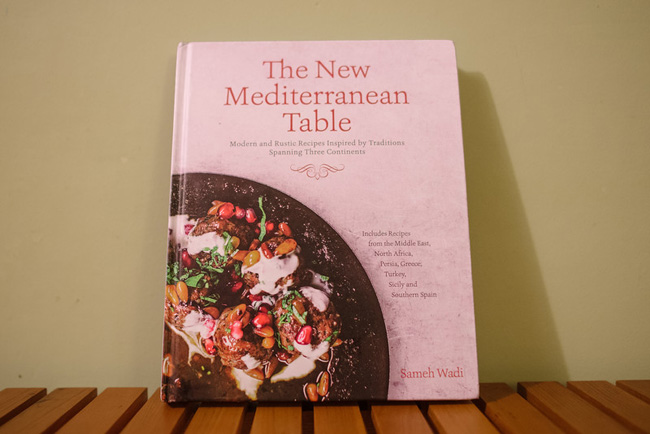
“The idea of eating in the Middle East, it’s like a sport, really,” says Chef Sameh Wadi. He’s out of his element cooking in my cramped South Minneapolis kitchen — not at Saffron or World Street Kitchen, or the WSK truck — but you’d never know it. He’s talking a mile a minute, and chopping, slicing, searing, and straining as he goes.
“We wake up — and the first thing my mom would say was ‘What do you guys want for breakfast?’” Here he paints an appealing picture: “Breakfast was a table filled with little mezzes, different cheeses, olives, pickles, hummus, sometimes chicken livers. … There’s got to be 10 items on the table, at least. …”
The context resonates right now, as our kitchen fills up with bright, deeply spiced food, and the chef flips through his newly released cookbook, The New Mediterranean Table. Food is everywhere: on the counters, on the stovetop, on the plates, in the air, and soon — in our mouths.
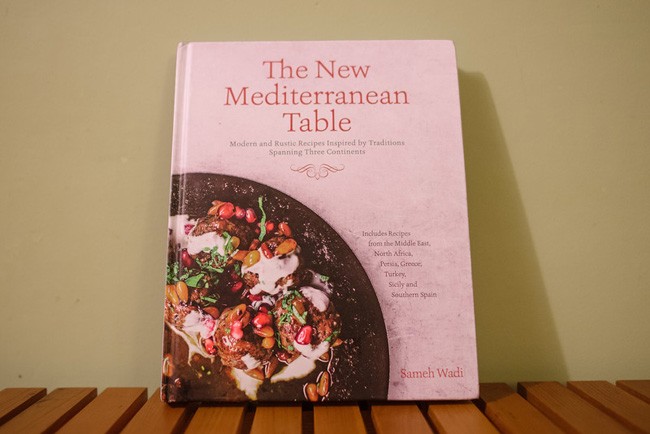
Wadi continues his story: “And then: ‘What do you guys want for lunch?’ And lunch was the biggest meal of the day. And then: ‘What do you guys want for dinner?’ Around 3 o’clock, people are done working. They don’t want to have a heavy meal right when they get home, so they start out with something lighter. But dinner was the late-night one, at 8 o’clock or so — basically all mezzes, is how we ate. At lunch there was always one or two big stews that go with rice.”
He pauses for effect: “And throughout the day there was snacking.”
The interweaving of eating and family life is at the core of The New Mediterranean Table, which is overstuffed with recipes that represent and reflect the flavors and textures of their region. The range of recipes is admirably broad, from short, simple dishes that any observant cook could pull off to potentially life-changing challenges, including formidable spice blends (the ras el hanout has 21 components, including saffron threads and something called orris root) and a glorious-looking chicken bastela that I intend to attempt sometime between now and the day I die, although the complexity of the dish will no doubt result in one or two postponements.

The New Mediterranean Table is a book as elegant as any dish that has emerged from the kitchen at Saffron. It’s clean, crisp, and clear, the recipes easy to read and swimming in white space, the photos bold and colorful without feeling forced or styled. Best of all is Wadi’s voice, which rings out from the pages as he introduces each dish — it’s warm, informative, and conversational without being wordy or feeling forced.
The book’s sections run from small plates through to dessert, drinks, and an unusual section entitled “The Larder.”

“It’s really, truly the heart of the book,” says Wadi. “It has the spice blends, basic sauces, pickles, things like that, that you wouldn’t think were such important components to a cuisine, but they’re what makes a cuisine what it really is.” Stock, yogurt, and spice blends define this part of the book and, says Wadi, the cuisine itself. Learn the basics, and the road can take you anywhere you’d like.
“You can use garam masala and take something as simple as a chicken breast or piece of fish and give it the undertone from the Mediterranean,” he says. “There’s charmoula, harissa … and the homemade thick yogurt that turns into yogurt cheese — it’s one of the simplest things in the world, but it tells you stories of the people.”
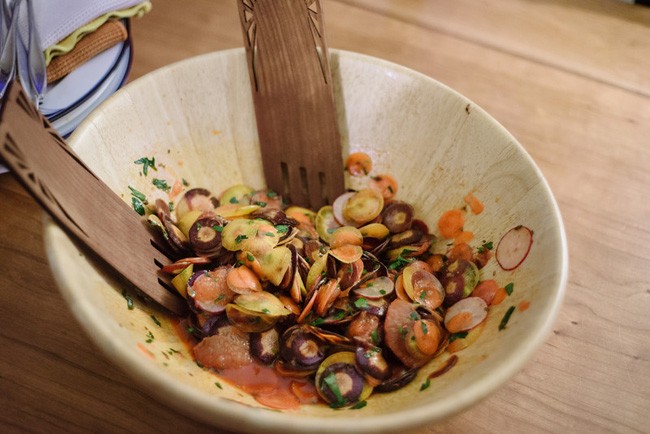
To preview the flavors of the book for us in three courses, Wadi prepared three dishes. The first was the book’s Carrot Salad with Grapefruit and Charmoula. Color: dazzling. Flavor: waves of brightness, acid, sweetness, and depth of spice. A carrot salad seems like it should be a meek, tame dish. This thing was a tiger.
“I have recipes that are very very simple, such as this one right here. It’s just a carrot salad,” he says. He pauses and smiles, and then adds, “The thing with simple is it’s really complicated.”
I see it at the restaurant. When I tell my cooks, ‘we’re limiting this to X amount of ingredients, …’ they stop, and they starting thinking, ‘How am I going to get the flavor profiles I want with this many ingredients? …’ And that’s where the creativity starts coming in.”
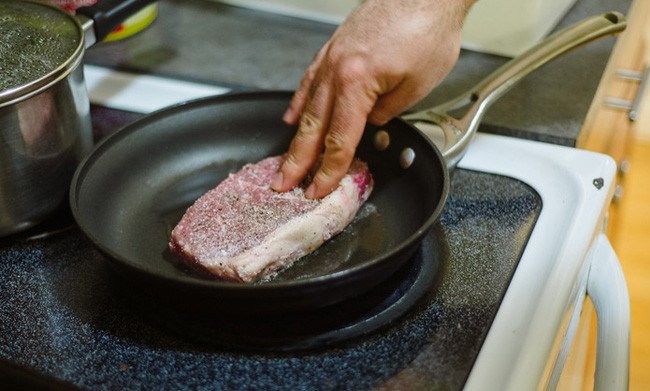
The second course that Wadi cooked was Grilled Beef Lettuce Wraps with Tabbouleh (recipe below).
“This is how we snack at home, particularly when my father was around,” says Wadi. “We didn’t really eat heavy meals, particularly when he was in charge. We ate fish, deep-fried. It was all about the starters, and they were all vegetarian. This takes it into a different realm, but we start with a little salad — the lettuce wraps just remind me of home.”
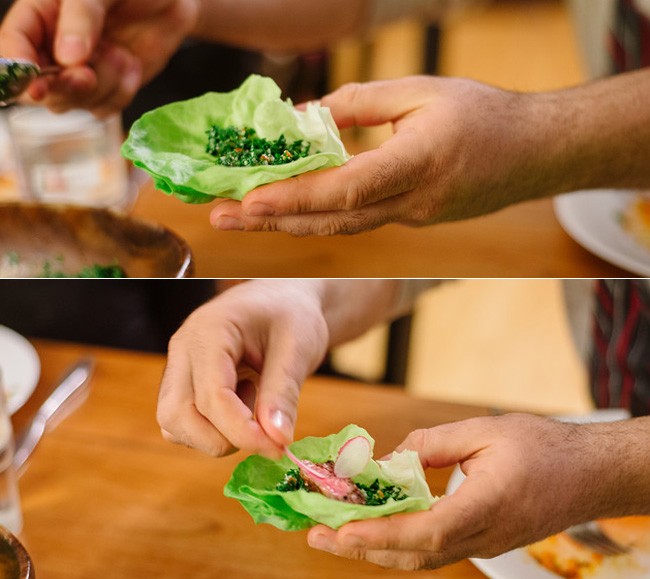
This light, bright, richly satisfying dish is a meal that I prepared on my own after Wadi’s visit, to put the book through its paces. The recipe worked like a charm, even if Wadi’s grilled steak was a bit more skillfully cooked than my own. It worked well enough that I made it again a few nights later — because I was hungry, and it was easy to make, and delicious.
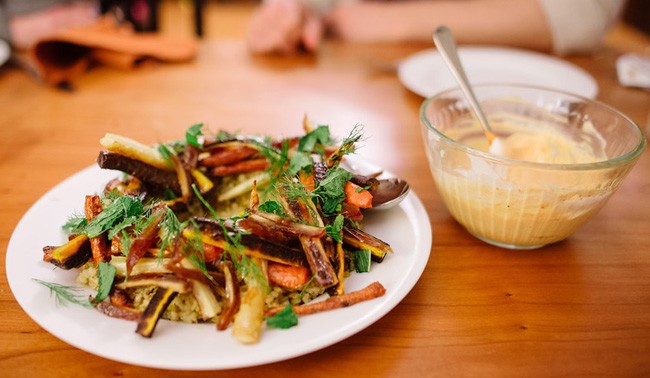
Wadi’s final course was a dessert, kind of — and a salad, kind of. And it looked and tasted like nothing we’d tried before. Freekeh with Roasted Carrots and Medjool Dates brought together warm roastiness, mint and dill brightness, date sweetness, and the the smokiness of freekeh, which is charred green wheat.
“The spicy’s in the yogurt,” says Wadi. “Dates and carrots are the sweet. It’s savory, it’s spicy, it’s sweet. Try the sauce with the dates – that’s where the magic happens.”
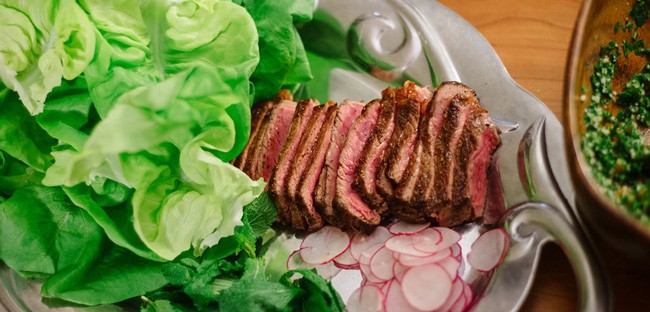
Grilled Beef Lettuce Wraps with Tabbouleh
From The New Mediterranean Table by Sameh Wadi
4 servings as an appetizer, 2 as a light meal
For the Steak
2 (12 oz.) pieces of beef strip loin or rib eye
1 Tbsp canola oil
Sea salt
Fresh ground black pepper
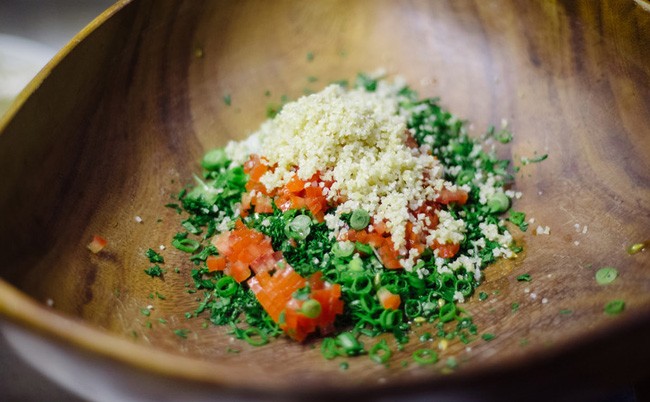
For the Tabbouleh
2 Tbsp fine bulgur wheat
2 cups flat-leaf parsley, finely chopped
¼ cup finely chopped fresh tomato
1 green onion, thinly sliced
3 Tbsp fresh mint, torn
2 Tbsp fresh lemon juice
3 Tbsp extra virgin olive oil
Sea salt
Fresh ground black pepper
To Serve
1 head Bibb lettuce, leaves separated
3 small radishes, thinly sliced
For the Steak
Preheat the gas or charcoal grill or grill pan to moderate-high heat.
Bring the steaks to room temperature. Brush with canola oil and season liberally with sea salt and black pepper. Grill the steaks until firm and charrred on the outside, about 2-5 minutes per side, depending on their thickness and how you like the meat done. Place the steaks on a cutting board; rest the meat for 5 minutes. Slice the steaks crosswise into ½″-thick slices.
For the Tabbouleh
Place the bulgur in a fine-mesh strainer, rinse under running water and rub with your fingertips until the water starts to run clear. Drain the water and place in a medium mixing bowl and let stand for 10-15 minutes. With a fork, fluff and break up the bulgur; it should have softened by this time. If it doesn’t, add a few drops of a water or tomato juice from cutting the tomatoes. Mix the remaining ingredients with the bulgur, then season with salt and a liberal dose of black pepper. The final product should be a little spicy from the black pepper with a balanced acidity.
To Serve
Arrange the lettuce leaves on a large platter or individual plates. Spoon tabbouleh in the center of the lettuce, top with the beef and sliced radishes and serve immediately.
Chef’s Tip
As you will notice here, the bulgur is not cooked. In my opinion, fine bulgur doesn’t need to be cooked; it absorbs enough liquid by being rinsed or soaked for a few minutes. To impart more flavor, you can soak it in lemon juice or some of the tomato juice drippings from cutting the tomatoes.

